- Joined
- Mar 23, 2008
- Messages
- 19
- Points
- 0
yesterday i was messing around with my green laser and some lens from an old Polaroid and i noticed something weird. when i put the laser up to a small blue lens it slightly changed the tone of the laser. you could barely tell but it had a bluer color to it. is it possible to drastically change the color of your laser like from red to orange or from green to bluish green using colored lens or glass?




